|
|
The Venerable Female Xenia [Ksenia]![The Venerable Female Xenia [Ksenia]](kalendar_new/det_kal_imgs/25-00.jpg) Xenia was born in Rome, the only daughter of a prominent senator. Drawn by love for Christ, she refused to enter into marriage as her parents wished, but rather, to avoid this, she secretly fled from her home with two of her slaves and arrived at the Island of Cos to a place called Mylassa. There she founded a convent for virgins where she lived an ascetical life until her death. Even though she was a frail woman, she possessed a steadfast endurance in fasting, prayer and all-night vigils. She often stood all night in prayer; she was dressed more poorly than all the other sisters; and the bread which she ate, she often sprinkled with ashes from the censer [thurible]. At the time of her death (450 A.D.), a wonderful sign appeared over the virgin"s convent: a wreath of stars with a cross in the center, brighter than the sun. Many, who were sick, received healing from her relics. Her female slaves [tonsured nuns] continued in the example of their abbess and when they died, and according to their wishes, were buried at the feet of Blessed Xenia [Ksenia]. Xenia was born in Rome, the only daughter of a prominent senator. Drawn by love for Christ, she refused to enter into marriage as her parents wished, but rather, to avoid this, she secretly fled from her home with two of her slaves and arrived at the Island of Cos to a place called Mylassa. There she founded a convent for virgins where she lived an ascetical life until her death. Even though she was a frail woman, she possessed a steadfast endurance in fasting, prayer and all-night vigils. She often stood all night in prayer; she was dressed more poorly than all the other sisters; and the bread which she ate, she often sprinkled with ashes from the censer [thurible]. At the time of her death (450 A.D.), a wonderful sign appeared over the virgin"s convent: a wreath of stars with a cross in the center, brighter than the sun. Many, who were sick, received healing from her relics. Her female slaves [tonsured nuns] continued in the example of their abbess and when they died, and according to their wishes, were buried at the feet of Blessed Xenia [Ksenia].The Holy-Priest Martyr Babylas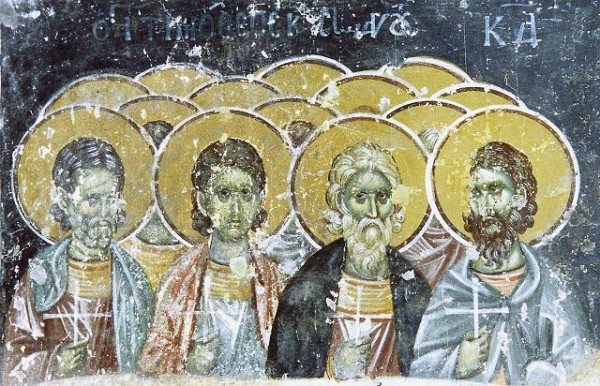 Babylas was a priest in Sicily. He suffered for Christ with two of his disciples in the third century. Babylas was a priest in Sicily. He suffered for Christ with two of his disciples in the third century.The Venerable Macedonius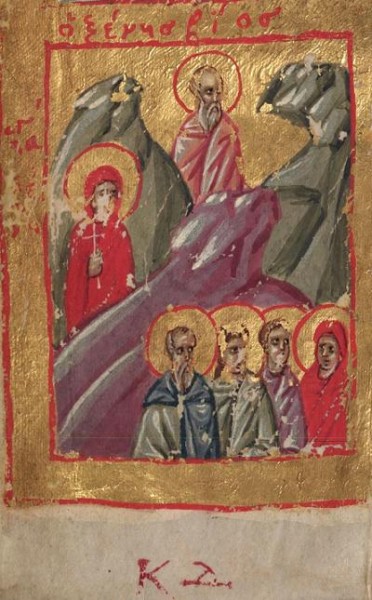 Macedonius was a Syrian hermit. Only in his old age did he feed on baked bread, but before that he ate only grains of barley softened with water. He ended his earthy life in the year 418 A.D. Macedonius was a Syrian hermit. Only in his old age did he feed on baked bread, but before that he ate only grains of barley softened with water. He ended his earthy life in the year 418 A.D.Venerable Philon, Bishop Of Cyprus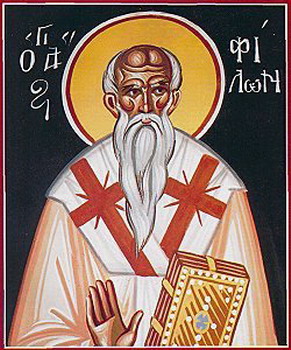 When St. Epiphanius was summoned to Rome to assist the sister of the Emperor Honorius by his prayer, he consecrated Philon a bishop. Philon exegeted the Pentateuch and the Song of Songs. He died peacefully in the fifth century. When St. Epiphanius was summoned to Rome to assist the sister of the Emperor Honorius by his prayer, he consecrated Philon a bishop. Philon exegeted the Pentateuch and the Song of Songs. He died peacefully in the fifth century.The Venerable Dionysius Of Olympus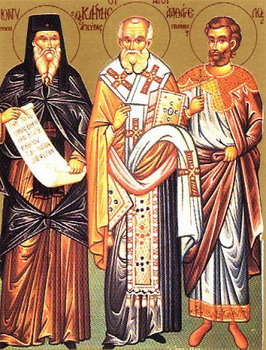 Dionysius was a miracle-worker. He lived an ascetical life on Mt. Olympus. He was tonsured a monk on Mt. Athos [The Holy Mountain] where he was the abbot of the Monastery Philotheou. Toward the end of his life, he withdrew into solitude on Mt. Olympus where he died in the sixteenth century. Dionysius was a miracle-worker. He lived an ascetical life on Mt. Olympus. He was tonsured a monk on Mt. Athos [The Holy Mountain] where he was the abbot of the Monastery Philotheou. Toward the end of his life, he withdrew into solitude on Mt. Olympus where he died in the sixteenth century.Blessed Xenia of St Petersburg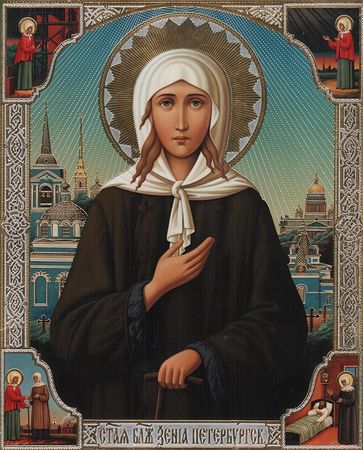 Saint Xenia lived during the eighteenth century, but little is known of her life or of her family. She passed most of her life in Petersburg during the reigns of the empresses Elizabeth and Catherine II.
Xenia Grigorievna Petrova was the wife of an army officer, Major Andrew Petrov. After the wedding, the couple lived in St Petersburg. St Xenia became a widow at the age of twenty-six when her husband suddenly died at a party. She grieved for the loss of her husband, and especially because he died without Confession or Holy Communion.
Once her earthly happiness ended, she did not look for it again. From that time forward, Xenia lost interest in the things of this world, and followed the difficult path of foolishness for the sake of Christ. The basis for this strange way of life is to be found in the first Epistle to the Corinthians (1 Cor. 1:18-24, 1 Cor. 2:14, 1 Cor. 3:18-19). The Lord strengthened her and helped her to bear sorrow and misfortune patiently for the next forty-five years.
She started wearing her husband’s clothing, and insisted that she be addressed as “Andrew Feodorovich.” She told people that it was she, and not her husband, who had died. In a certain sense, this was perfectly true. She abandoned her former way of life and experienced a spiritual rebirth. When she gave away her house and possessions to the poor, her relatives complained to the authorities. After speaking to Xenia, the officials were conviced that she was in her right mind and was entitled to dispose of her property as she saw fit. Soon she had nothing left for herself, so she wandered through the poor section of Petersburg with no place to lay her head. She refused all assistance from her relatives, happy to be free of worldly attachments.
When her late husband’s red and green uniform wore out, she clothed herself in rags of those colors. After a while, Xenia left Petersburg for eight years. It is believed that she visited holy Elders and ascetics throughout Russia seeking instruction in the spiritual life. She may have visited St Theodore of Sanaxar (February 19), who had been a military man himself. His life changed dramatically when a young officer died at a drinking party. Perhaps this officer was St Xenia’s husband. In any case, she knew St Theodore and profited from his instructions.
St Xenia eventually returned to the poor section of Petersburg, where she was mocked and insulted because of her strange behavior. When she did accept money from people it was only small amounts, which she used to help the poor. She spent her nights praying without sleep in a field outside the city. Prayer strengthened her, and in her heart’s conversation with the Lord she found the support she needed on her difficult path.
When a new church was being built in the Smolensk cemetery, St Xenia brought bricks to the site. She did this in secret, during the night, so that no one would know.
Soon her great virtue and spiritual gifts began to be noticed. She prophesied future events affecting the citizens of Petersburg, and even the royal family. Against her will, she became known as someone pleasing to God, and nearly everyone loved her.They said, “Xenia does not belong to this world, she belongs to God.” People regarded her visits to their homes or shops as a great blessing. St Xenia loved children, and mothers rejoiced when the childless widow would stand and pray over a baby’s crib, or kiss a child. They believed that the blessed one’s kiss would bring that child good fortune.
St Xenia lived about forty-five years after the death of her husband, and departed to the Lord at the age of seventy-one. The exact date and circumstances of her death are not known, but it probably took place at the end of the eighteenth century. She was buried in the Smolensk cemetery.
By the 1820s, people flocked to her grave to pray for her soul, and to ask her to intercede with God for them. So many visitors took earth from her grave that it had to be replaced every year. Later, a chapel was built over her grave.
Those who turn to St Xenia in prayer receive healing from illness, and deliverance from their afflictions. She is also known for helping people who seek jobs.
Troparion — Tone 5
Having lived as a stranger in the world, / you outwitted the deviser of evil / by your pretended foolishness, O Xenia. / You received the grace from God / to foresee and foretell things to come. / Now, as you have been translated from earth to heaven, / you are numbered with the choirs of the angels.
Kontakion — Tone 4
Podoben: “Today You have shown forth...” / You gave your wealth to the poor, O Xenia, / and accepted poverty out of love for Christ; / having lived a life rivaling the angels, you were accounted worthy of glory on high. Saint Xenia lived during the eighteenth century, but little is known of her life or of her family. She passed most of her life in Petersburg during the reigns of the empresses Elizabeth and Catherine II.
Xenia Grigorievna Petrova was the wife of an army officer, Major Andrew Petrov. After the wedding, the couple lived in St Petersburg. St Xenia became a widow at the age of twenty-six when her husband suddenly died at a party. She grieved for the loss of her husband, and especially because he died without Confession or Holy Communion.
Once her earthly happiness ended, she did not look for it again. From that time forward, Xenia lost interest in the things of this world, and followed the difficult path of foolishness for the sake of Christ. The basis for this strange way of life is to be found in the first Epistle to the Corinthians (1 Cor. 1:18-24, 1 Cor. 2:14, 1 Cor. 3:18-19). The Lord strengthened her and helped her to bear sorrow and misfortune patiently for the next forty-five years.
She started wearing her husband’s clothing, and insisted that she be addressed as “Andrew Feodorovich.” She told people that it was she, and not her husband, who had died. In a certain sense, this was perfectly true. She abandoned her former way of life and experienced a spiritual rebirth. When she gave away her house and possessions to the poor, her relatives complained to the authorities. After speaking to Xenia, the officials were conviced that she was in her right mind and was entitled to dispose of her property as she saw fit. Soon she had nothing left for herself, so she wandered through the poor section of Petersburg with no place to lay her head. She refused all assistance from her relatives, happy to be free of worldly attachments.
When her late husband’s red and green uniform wore out, she clothed herself in rags of those colors. After a while, Xenia left Petersburg for eight years. It is believed that she visited holy Elders and ascetics throughout Russia seeking instruction in the spiritual life. She may have visited St Theodore of Sanaxar (February 19), who had been a military man himself. His life changed dramatically when a young officer died at a drinking party. Perhaps this officer was St Xenia’s husband. In any case, she knew St Theodore and profited from his instructions.
St Xenia eventually returned to the poor section of Petersburg, where she was mocked and insulted because of her strange behavior. When she did accept money from people it was only small amounts, which she used to help the poor. She spent her nights praying without sleep in a field outside the city. Prayer strengthened her, and in her heart’s conversation with the Lord she found the support she needed on her difficult path.
When a new church was being built in the Smolensk cemetery, St Xenia brought bricks to the site. She did this in secret, during the night, so that no one would know.
Soon her great virtue and spiritual gifts began to be noticed. She prophesied future events affecting the citizens of Petersburg, and even the royal family. Against her will, she became known as someone pleasing to God, and nearly everyone loved her.They said, “Xenia does not belong to this world, she belongs to God.” People regarded her visits to their homes or shops as a great blessing. St Xenia loved children, and mothers rejoiced when the childless widow would stand and pray over a baby’s crib, or kiss a child. They believed that the blessed one’s kiss would bring that child good fortune.
St Xenia lived about forty-five years after the death of her husband, and departed to the Lord at the age of seventy-one. The exact date and circumstances of her death are not known, but it probably took place at the end of the eighteenth century. She was buried in the Smolensk cemetery.
By the 1820s, people flocked to her grave to pray for her soul, and to ask her to intercede with God for them. So many visitors took earth from her grave that it had to be replaced every year. Later, a chapel was built over her grave.
Those who turn to St Xenia in prayer receive healing from illness, and deliverance from their afflictions. She is also known for helping people who seek jobs.
Troparion — Tone 5
Having lived as a stranger in the world, / you outwitted the deviser of evil / by your pretended foolishness, O Xenia. / You received the grace from God / to foresee and foretell things to come. / Now, as you have been translated from earth to heaven, / you are numbered with the choirs of the angels.
Kontakion — Tone 4
Podoben: “Today You have shown forth...” / You gave your wealth to the poor, O Xenia, / and accepted poverty out of love for Christ; / having lived a life rivaling the angels, you were accounted worthy of glory on high.
Martyrs Agapius and TimothySaints Agapius and Timothy, disciples of St Babylas of Sicily, lived during the third century on the outskirts of Rome.
Sts Timothy and Agapius labored with St Babylas on a mountain, where they struggled in fasting, prayer and silence. Fleeing a persecution by the pagans, St Bablyas and his disciples went to the island of Sicily, where they converted many unbelievers to Christ.
The governor of the island, angered by the missionary activity of St Babylas, ordered that he and his disciples be arrested, and he also had them tortured. The saints patiently endured their sufferings, and all three died by the sword. Their bodies were thrown into a fire, but the flames did not harm the warriors of Christ. They were buried on the island of Sicily by local Christians.
Hieromartyr PhilippicusThe Hieromartyr Philippicus the Presbyter and the Martyr Barsimos and two brothers were beheaded for their confession of faith in Christ.
Martyrs Pausirius, Paul and TheodotionThe Holy Martyrs Pausirius, Paul, and Theodotion lived in Egypt during the third century. They were two brothers who confessed their faith in Christ and suffered martyrdom under Diocletian (284-305). Their brother Theodotion converted to Christianity after witnessing their martyrdom. He also endured many torments before being put to death.
Martyrs Hermogenes and Menas (Mamas, Mamatos)
Martyr BarsimosThe Hieromartyr Philippicus the Presbyter and the Martyr Barsimos and two brothers were beheaded for their confession of faith in Christ.
Venerable ZosimasAscetic of the desert
Venerable Neophytus the Recluse, of Cyprus, Wonderworker (1204)Martyr John of Kazan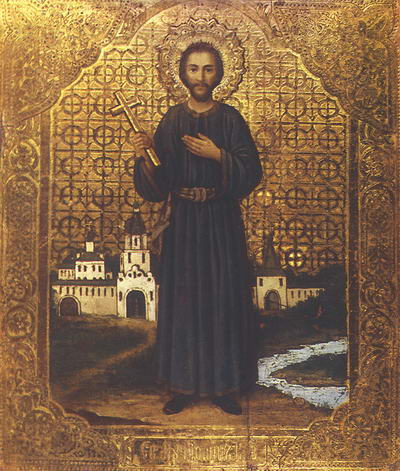 The Martyr John of Kazan suffered for Christ in the city of Kazan on January 24, 1529. During the reign of Great Prince Basil the Tatars swooped down upon Nizhni Novgorod. Many of the inhabitants were taken into captivity and brought to Kazan. Also among their number was the fearless John.
When the captives were distributed to their new owners, he was given to Alei-Shnura, who was related to the Khan. By day John honestly served his master, but at night he went without sleep and prayed, patiently enduring insults and abuse. The master resolved to force his servant to become a Moslem, but John firmly declared that he worshiped Jesus Christ as God.
In the winter the Tatars tied him up and led him to a Russian cemetery, mortally wounded him with swords, and threw him into the snow. That night, St John reached the door of some Russians living in Kazan, and he asked them to summon a priest. He received the Holy Mysteries and prayed all night, then died the following morning. The Martyr John of Kazan suffered for Christ in the city of Kazan on January 24, 1529. During the reign of Great Prince Basil the Tatars swooped down upon Nizhni Novgorod. Many of the inhabitants were taken into captivity and brought to Kazan. Also among their number was the fearless John.
When the captives were distributed to their new owners, he was given to Alei-Shnura, who was related to the Khan. By day John honestly served his master, but at night he went without sleep and prayed, patiently enduring insults and abuse. The master resolved to force his servant to become a Moslem, but John firmly declared that he worshiped Jesus Christ as God.
In the winter the Tatars tied him up and led him to a Russian cemetery, mortally wounded him with swords, and threw him into the snow. That night, St John reached the door of some Russians living in Kazan, and he asked them to summon a priest. He received the Holy Mysteries and prayed all night, then died the following morning. |